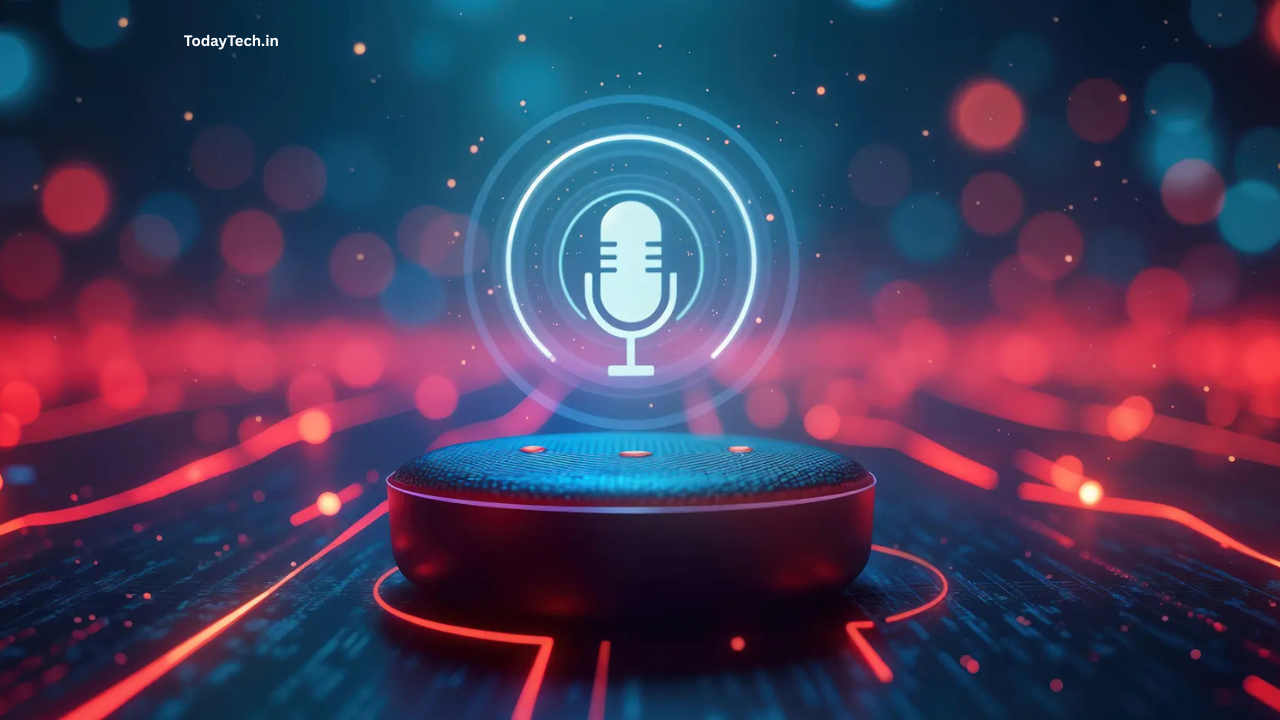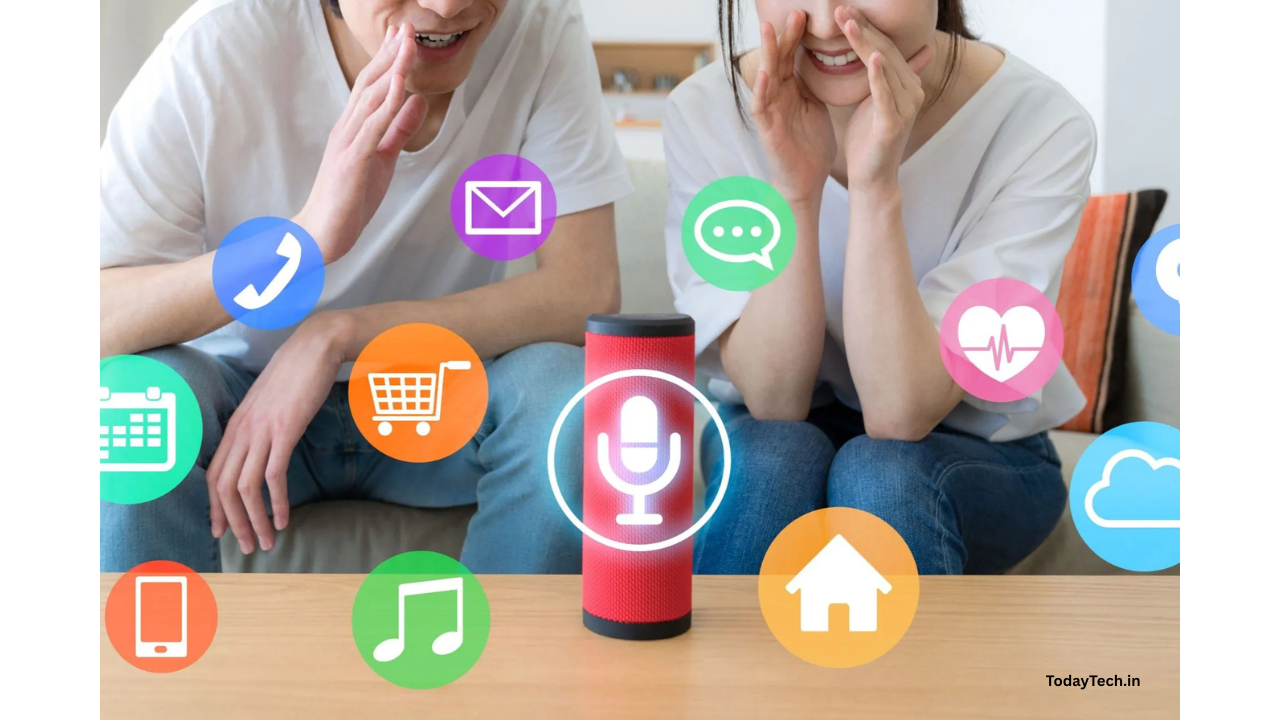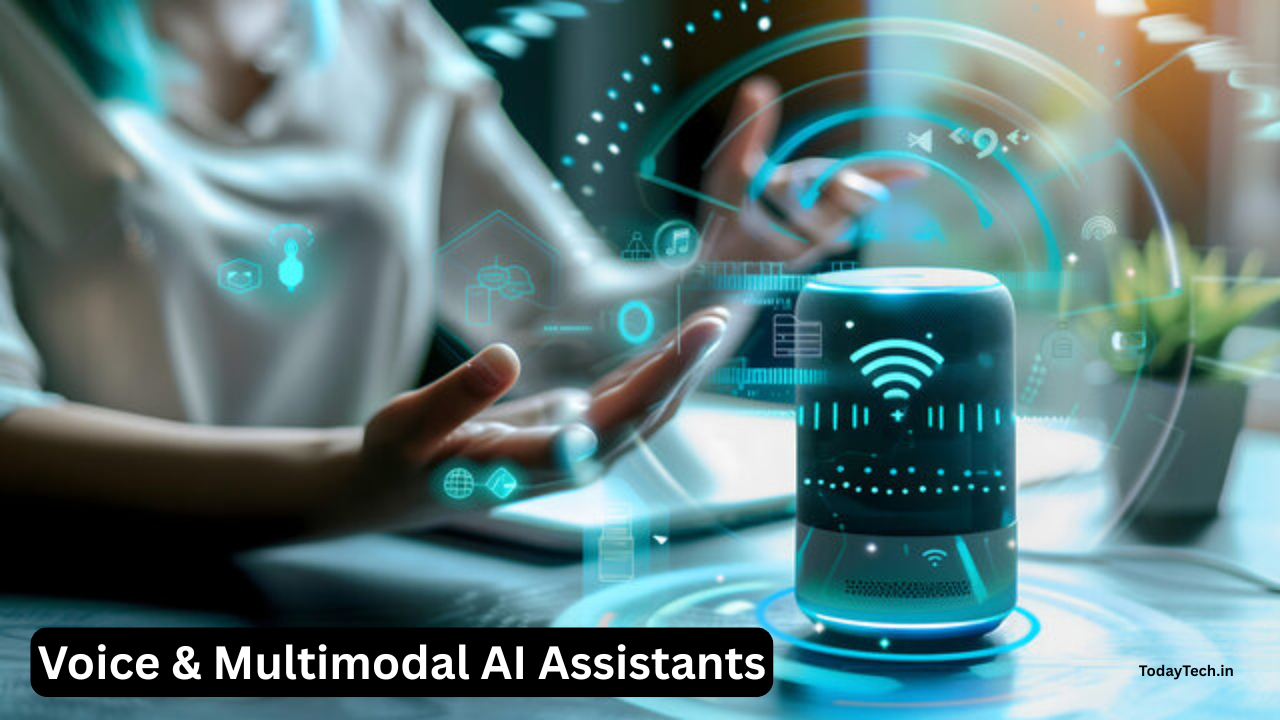The faint glow of smartphone screen responsive smart speaker in the corner the subtle intelligence embedded in our cars and wearables these are the modern day campfires around which we navigate our digital lives. For years we communicated with them primarily through one sense: voice. Wed ask for the weather command song to play or set timer. It was revolutionary but it was also conversation in the dark. Now in 2025 the lights have been turned on. We are firmly in the era of Voice & Multimodal AI Assistants sophisticated digital companions that dont just hear us but also see understand and interact with the world in way that mirrors human perception.
This guide is your comprehensive map to this exciting and rapidly evolving landscape. Were moving beyond simple voice commands into world of “show and tell” where you can point your camera at plant and ask “Whats wrong with this leaf?” or glance at your calendar while asking your assistant to “move that meeting to time when Im free.” This fusion of inputs voice vision text touch and sensor data is the essence of multimodality. Its the technology that makes interaction with AI not just easier but profoundly more natural intuitive and powerful.
This article will delve deep into the core technologies key players real world applications and ethical considerations surrounding the Voice & Multimodal AI Assistants of 2025. Whether youre tech enthusiast developer business leader or simply curious about the future this guide will equip you with the knowledge to understand and harness the power of the most significant shift in human computer interaction since the graphical user interface.
The Journey from Voice Only to Rich Multimodal Experiences
To truly appreciate the revolution of 2025 we must first look back at the journey. The first wave of digital assistants spearheaded by the likes of Siri Alexa and Google Assistant was an auditory centric marvel. They democratized AI placing the power of natural language processing in millions of homes and pockets. The ability to speak command and have it executed felt like science fiction come to life.
However the limitations of voice only interface quickly became apparent. Communication without context is inherently difficult. Humans dont just rely on words; we use gestures facial expressions and shared visual understanding. voice only assistant couldnt understand what “this” or “that” referred to. It couldnt interpret users confusion from their expression or understand complex request that involved visual element like “Help me fix this leaky faucet” without the ability to see the faucet. This communication gap was the primary catalyst for the evolution toward multimodality.
The transition to Voice & Multimodal AI Assistants wasnt an overnight switch but gradual enrichment of capabilities. It started with smart displays like the Amazon Echo Show and Google Nest Hub which added screen to the smart speaker. This simple addition bridged crucial gap allowing assistants to show you the weather forecast display recipe steps or stream security camera feed. This was the first step.
The true leap forward came with the integration of advanced computer vision powered by sophisticated AI models directly into the core of these assistants particularly on smartphones. Suddenly the smartphones camera became the eyes of the AI. This convergence created powerful synergy where language provides the intent and vision provides the context. This evolution reflects fundamental truth: we live in multimodal world and for technology to integrate seamlessly into our lives it must communicate on our terms. The Voice & Multimodal AI Assistants of today are designed to do just that creating fluid context aware dialogue between human and machine.
Deconstructing the “Multimodal” in Voice & Multimodal AI Assistants
What exactly do we mean when we talk about “multimodality”? It refers to the ability of an AI system to process and understand information from multiple types or “modes” of data simultaneously. Its about creating holistic understanding that is greater than the sum of its parts. Lets break down the key modalities that empower the modern Voice & Multimodal AI Assistants.

Voice and Speech: The Conversational Core
Voice remains the bedrock of these assistants. Its the fastest and often most convenient way to communicate intent. The technologies here have matured exponentially.
- Natural Language Processing (NLP) & Understanding (NLU): In 2025 NLU has moved beyond rigid command and control (“Play music”) to understanding nuanced conversational language (“Find that upbeat indie song I was listening to yesterday afternoon”). Thanks to massive transformer based models Voice & Multimodal AI Assistants can parse complex sentences understand idiomatic expressions and infer intent with startling accuracy.
- Speech Synthesis: AI generated voices are now almost indistinguishable from human voices. They possess natural intonation rhythm and can even express emotion making interactions less robotic and more engaging.
Computer Vision: The Eyes of the AI
This is arguably the most transformative addition. The ability to see and interpret the physical world unlocks countless new capabilities.
- Object and Scene Recognition: You can point your phone at landmark piece of furniture or flower and the assistant can identify it. It doesnt just see pixels; it understands concepts. It can recognize “kitchen scene” and infer that you might be interested in recipes.
- Text Recognition (OCR): Optical Character Recognition allows an assistant to read text from anywhere menu document street sign. This is invaluable for real time translation or for quickly digitizing information.
- Facial and Gesture Recognition: Assistants can now recognize familiar faces (with permission) to personalize experiences. They can also begin to interpret simple gestures like thumbs up or wave as form of non verbal input.
Text: The Precision Tool
While voice is immediate text remains essential for precision privacy and situations where speaking aloud is inappropriate. true Voice & Multimodal AI Assistant allows users to seamlessly switch between modalities. You might start query by voice and then refine it by typing specific name or address that is difficult to pronounce. This flexibility is crucial for truly user friendly experience.
Touch and Haptics: The Tactile Dimension
On devices with screens touch is an integral input method. Users can tap swipe and pinch to interact with the information presented by the assistant. This is complemented by haptics the use of vibration and force feedback. For example when Voice & Multimodal AI Assistant confirms payment subtle haptic buzz can provide reassuring tangible confirmation that voice alone cannot.
Sensor Fusion: Creating Complete Picture
The true magic of Voice & Multimodal AI Assistants lies in sensor fusion. This is the process of combining data from various sensors microphones cameras accelerometers gyroscopes GPS ambient light sensors to build rich real time understanding of the users context. For example the assistant might know youre driving because of GPS data and accelerometer readings and therefore present information in simplified glanceable interface while prioritizing voice interaction for safety. Its this deep contextual awareness that makes the assistant feel truly intelligent and proactive.
The Technological Backbone: Powering the Assistants of 2025
The seamless experience offered by todays Voice & Multimodal AI Assistants is the result of confluence of groundbreaking technological advancements. These are the engines running under the hood.
Large Multimodal Models (LMMs)
If Large Language Models (LLMs) like OpenAIs GPT series were the brains behind the text revolution Large Multimodal Models (LMMs) are the complete central nervous system for the current era. Models like Googles Gemini family are natively multimodal meaning they are trained from the ground up on vast and diverse dataset of text images audio video and code simultaneously.
This is fundamental paradigm shift. Previous “multimodal” systems often used separate models for each input type and then tried to stitch the results together. LMMs by contrast learn the intrinsic relationships and patterns between different data types. This allows them to perform sophisticated cross modal reasoning. For instance you can show an LMM powered assistant picture of ingredients on countertop and video of someone using specific kitchen tool and ask “What can I cook with these using that gadget?” Answering this requires deep integrated understanding of both visual inputs and the abstract concepts of cooking. This is the core technology that enables the most impressive features of modern Voice & Multimodal AI Assistants.
Edge AI and On Device Processing
The early days of AI assistants were heavily reliant on the cloud. Your voice command would be sent to massive data center processed and the response sent back. While powerful this introduced latency and significant privacy concerns.
The trend in 2025 is hybrid approach with strong emphasis on Edge AI. Powerful energy efficient chips in our smartphones and devices can now run sophisticated AI models locally. This on device processing has several key advantages:
- Speed: For many common requests the assistant can respond almost instantly as theres no round trip to the cloud.
- Privacy: Sensitive data like live camera feeds or personal queries can be processed on your device without ever leaving it. This is major selling point especially for privacy conscious brands like Apple.
- Offline Functionality: growing number of features work even without an internet connection making the assistant more reliable. The most advanced Voice & Multimodal AI Assistants use hybrid model handling sensitive or time critical tasks on device while leveraging the immense power of the cloud for more complex research heavy queries.
Contextual Awareness and Memory
An assistant that forgets the last thing you said is frustrating and unhelpful. The Voice & Multimodal AI Assistants of 2025 are built with persistent memory and deep sense of context. This works on multiple levels:
- Short Term Context: The ability to handle follow up questions without requiring the user to repeat information. For example “Who directed The Matrix?” followed by “What else has she directed?”
- Long Term Personalization: The assistant learns your preferences routines and relationships over time to provide proactive and personalized suggestions. It knows you prefer certain coffee shop that your “drive home” route should avoid tolls and who “Mom” is in your contacts.
- Environmental Context: Using sensor fusion the assistant is aware of your location the time of day and your current activity (walking driving working) adapting its behavior and suggestions accordingly.
Affective Computing (Emotional AI)
The next frontier in AI interaction is emotional intelligence. Affective Computing is an emerging field focused on developing AI that can recognize interpret and simulate human emotions. In the context of Voice & Multimodal AI Assistants this is manifesting in nascent but powerful ways. By analyzing vocal tone speech patterns and even facial expressions (via the camera) assistants can start to gauge the users emotional state. Is the user frustrated? Excited? Stressed? Recognizing these cues allows the assistant to tailor its response perhaps offering more empathetic tone or simplifying its explanation if it detects frustration. This technology is still in its early stages but is key to making interactions feel less transactional and more genuinely helpful and human like.
The 2025 Landscape: Look at the Key Players
The battle for dominance in the Voice & Multimodal AI Assistants arena is fierce with tech giants leveraging their unique ecosystems to offer compelling experiences.

Google Assistant with Gemini
Google has formidable advantage with its deep integration of the Gemini family of LMMs into the fabric of its ecosystem. The new “Assistant with Gemini” is less of command executor and more of conversational partner.
- Strengths: Unparalleled access to Googles knowledge graph (Search) real world context through Maps and Lens and deep integration with Android and its suite of productivity apps (Workspace). Its ability to understand and reason about on screen content and real world visuals is best in class. You can show it photo and have full conversation about it or ask it to summarize webpage youre currently viewing. This makes it an incredibly powerful Voice & Multimodal AI Assistant for information retrieval and real world interaction.
Amazon Alexa
Alexa built its empire on the smart home and that remains its core strength. While it was traditionally voice first Amazon has heavily invested in multimodality through its Echo Show devices and Fire TV platform.
- Strengths: Dominance in the smart home ecosystem with countless third party integrations (“skills”). Alexa is the de facto operating system for home automation. With its new LLM powered core conversations are more natural and its better at handling complex home automation routines. Its multimodal approach shines on devices like the Echo Show where it can display recipes show you who is at the door and facilitate video calls all driven by combination of voice and touch.
Apples Siri
Apples approach has always been deliberate balance between capability and user privacy. Siris strength lies in its deep on device integration with the iOS macOS and watchOS ecosystems.
- Strengths: Unmatched privacy due to its emphasis on on device processing. Siri excels at “getting things done” within the Apple ecosystem setting reminders sending messages controlling Apple Music and managing system settings. Its multimodal capabilities are tightly integrated allowing you to for example select text on your screen and ask Siri to “send this to Jane.” While historically seen as lagging in conversational AI Apples ongoing investment in powerful on device neural engines means the 2025 version of Siri is more responsive reliable and capable of handling more complex personalized tasks without compromising its privacy first ethos. Its prime example of Voice & Multimodal AI Assistant built on user trust.
Microsoft Copilot
Microsoft has strategically positioned Copilot as the ultimate productivity assistant. Its woven into the entire Microsoft 365 ecosystem from Windows itself to Teams Outlook and Office.
- Strengths: laser focus on the professional user. Copilot can summarize long email threads generate drafts in Word based on spoken outline create PowerPoint presentations from document and analyze data in Excel using natural language prompts. Its multimodality comes from its ability to understand the context of your work across different applications combining text voice commands and the data within your documents to supercharge productivity.
Emerging and Niche Players
Beyond the giants the landscape is peppered with innovative newcomers. Devices like the Rabbit R1 and the Humane Ai Pin are exploring new form factors for AI interaction moving beyond the smartphone. In the automotive space specialized Voice & Multimodal AI Assistants are becoming standard managing everything from navigation and climate control to vehicle diagnostics using both voice and in car cameras to monitor driver alertness.
Practical Applications: Reshaping Daily Life and Work
The true measure of any technology is its impact on our daily lives. Voice & Multimodal AI Assistants are moving from novelty to utility becoming indispensable tools across wide range of domains.
The Hyper Intelligent Smart Home
The smart home of 2025 is predictive and seamless. Your assistant doesnt just react to “turn on the lights.” It knows your routine. It might suggest “Shall I initiate the Wind Down scene?” as evening approaches which could dim the lights lower the blinds and play calming playlist. Visually you can ask your smart display “Show me view of the backyard” and it will instantly stream the feed from your security camera. Or you could show your smart fridges internal camera to your phone and ask “What can I make for dinner with whats left in here?”
The New Paradigm of Productivity
In the workplace Voice & Multimodal AI Assistants are acting as tireless collaborators. Imagine being in video conference; your assistant can provide real time transcript. After the call you can ask it “Summarize the key action items and create task list for my team” and it will do so by analyzing the transcript and even recognizing who spoke which lines. You could take screenshot of chart and ask your assistant “Draft an email to my manager explaining the Q3 sales trend shown here.” It combines the visual data from the chart with its language generation capabilities to create coherent draft instantly.
Revolutionizing Retail and E commerce
Multimodality is transforming how we shop. The concept of “visual search” is now mainstream. See pair of shoes you like on stranger? Snap picture and your assistant can find them or similar styles online for you to purchase. Augmented reality (AR) features allow you to use your phones camera to see how new sofa would look in your living room with the assistant guiding you through options and styles based on your verbal feedback. This blend of seeing and speaking makes for much richer and more confident shopping experience.
Health Fitness and Accessibility
This is one of the most impactful areas for Voice & Multimodal AI Assistants. For visually impaired users an assistant can function as pair of eyes describing their surroundings reading labels on products or helping them navigate unfamiliar places. In fitness an AI powered personal trainer can watch your form through your phones camera as you exercise providing real time verbal feedback to prevent injury and maximize effectiveness. For an elderly user an assistant can provide medication reminders facilitate easy video calls with family and detect falls using wearable sensors creating powerful safety net.
Education and Interactive Learning
The classroom is also being transformed. student struggling with math problem can show their written work to tablet and tutoring assistant can visually identify the error and provide step by step verbal explanation. Language learning apps use the camera to identify objects around you providing the name in the language youre learning while also correcting your pronunciation when you speak the word. This interactive multi sensory approach makes learning more engaging and effective.
The Ethical Maze: Navigating the Challenges of an Always On World
The immense power of Voice & Multimodal AI Assistants comes with host of complex ethical challenges and societal questions that we must address thoughtfully.
The Privacy Quagmire
The very nature of multimodal assistant with its always on microphones and cameras brings privacy to the forefront. How is our data being collected stored and used? While on device processing mitigates some risks many advanced features still rely on the cloud. Users need transparent controls and clear information about what data is being shared and for what purpose. The potential for misuse whether for targeted advertising or more nefarious purposes is significant concern that requires robust regulation and corporate accountability.
Security Vulnerabilities
An interconnected device that can see and hear everything in your home is prime target for hackers. The risks range from eavesdropping on private conversations to manipulating smart home devices. Securing these systems against attacks like voice spoofing (using deepfakes to imitate users voice) and other cyber threats is continuous and critical challenge for developers.
The Pervasive Problem of Bias
AI models are trained on data and if that data reflects societal biases the AI will inherit and potentially amplify them. Voice & Multimodal AI Assistant might be less effective at understanding certain accents or dialects. Facial recognition systems have historically shown lower accuracy rates for women and people of color. Ensuring that the training data is diverse and representative and that models are continuously audited for fairness is essential to creating technology that serves everyone equitably.
Over reliance and the Erosion of Skills
As these assistants become more capable there is risk of cognitive offloading. Will we become too dependent on them to navigate to remember information or even to make simple decisions? Theres fine line between helpful tool that augments human intelligence and crutch that leads to the erosion of fundamental skills and critical thinking. Fostering culture of mindful technology use is crucial as these powerful Voice & Multimodal AI Assistants become further integrated into our lives.
Beyond 2025: The Future is Proactive and Autonomous
As powerful as the Voice & Multimodal AI Assistants of 2025 are they represent point on trajectory not the final destination. The coming years promise even more profound transformations.

The Shift to Proactive Autonomous Agents
The next evolution is from reactive assistant to proactive agent. Instead of waiting for you to ask the assistant of the future will anticipate your needs and take action on your behalf. Imagine your assistant noticing flight delay in your email cross referencing it with your calendar and then proactively rebooking your airport transfer and notifying the relevant parties of your new arrival time all without single command from you. These AI agents will have the autonomy to perform complex multi step tasks across different apps and services to achieve users goal.
Deep Integration with Spatial Computing (AR/VR)
The ultimate platform for Voice & Multimodal AI Assistants is not the phone or the speaker but pair of lightweight augmented reality glasses. In this world of spatial computing your assistant will be able to see exactly what you see. It could provide real time visual turn by turn directions overlaid on the street in front of you. When meeting someone it could subtly display their name and your last interaction with them in your field of view. This will be the truest form of multimodality seamless blend of the digital and physical worlds all navigated by voice gesture and gaze.
Hyper Personalization and Digital Twins
Future assistants will build such deep and nuanced understanding of our preferences habits and knowledge that they will function as “digital twin” of our personal and professional lives. This hyper personalized agent will be able to brief you on your day with an uncanny understanding of whats important to you draft emails in your exact style and negotiate scheduling conflicts with the same priorities you would.
Embracing the New Dialogue
We stand at remarkable juncture in the history of technology. The transition to Voice & Multimodal AI Assistants is as fundamental as the shift from the command line to the graphical user interface. By breaking free from the constraints of single input method we are creating relationship with technology that is more intuitive contextual and deeply human.
The journey of 2025 has been about adding senses to our digital companions giving them eyes to complement their ears. The path ahead lies in giving them greater autonomy and intelligence moving them from assistants to true partners.
The challenges of privacy security and bias are significant and require our constant vigilance. But the potential to enhance our productivity creativity accessibility and connection to the world is undeniable. The era of silent passive devices is over. The future is dynamic multi sensory conversation and the remarkable Voice & Multimodal AI Assistants of 2025 are teaching us all how to speak its language.

